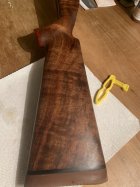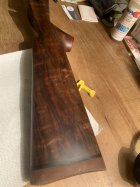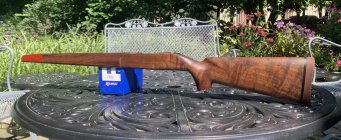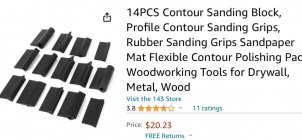You are using an out of date browser. It may not display this or other websites correctly.
You should upgrade or use an alternative browser.
You should upgrade or use an alternative browser.
Need Advice on Finishing my Wood Stock
- Thread starter CjC73
- Start date
What Josh said, it looks like yo could stand a lil more clearance under barrel.
Thanks guys....
It clears now but stock flexes a bit so I'll sand that down some more. Wanted to get the outside done first.
Headed on vacation tomorrow for a week so get to it when I return.
joshb
Gold $$ Contributor
That’s a lack of commitment!!Thanks guys....
It clears now but stock flexes a bit so I'll sand that down some more. Wanted to get the outside done first.
Headed on vacation tomorrow for a week so get to it when I return.
Good for the soul! I’ve taken a few stocks on vacation to finish them!
Actually, I might!That’s a lack of commitment!!Take it with you! Finishing a stock is like meditation!
Good for the soul! I’ve taken a few stocks on vacation to finish them!
Do you wipe it down with mineral spirits between grits?
Probably should leave the barreled action at home, other campers may not enjoy that. Hahahaha
I think I did a while ago. But I'll definitely reread it.I don’t “wipe my stocks down” with anything . Sanded wood is free of grease or other contaminates. Why would you?
Have you looked at my “Do it yourself stockmaking” thread?
joshb
Gold $$ Contributor
It’s pretty long because of all the added comments but the short version is that I don’t use any solvents on the wood except when I’m gluing Ebony. I use oil as a finish, so I leave the sanding dust on the stock when I put on the first coat of oil. It helps fill the pores. I sand them to 1000 grit before they get any oil.
And I just learned something if I was to ever do an oil finish.It’s pretty long because of all the added comments but the short version is that I don’t use any solvents on the wood except when I’m gluing Ebony. I use oil as a finish, so I leave the sanding dust on the stock when I put on the first coat of oil. It helps fill the pores. I sand them to 1000 grit before they get any oil.
I would make the length of the forend at least two of the users hand widths with gloves on ahead of the trigger guard. The other measurement is that the balance point for the rifle when ready for use needs to be ahead of the trigger guard about two hand widths
joshb
Gold $$ Contributor
Here’s one I finished today. Sanded to 1000 grit, I left the precious dust in the pores and put a heavy coat of oil on it. I use my finger to apply it. A finger acts like a squeegee and pushes the slurry into the pores. A cloth would soak up the slurry. I’ll let it dry, then hand sand the stock with 1500 grit before another coat of oil.



That's amazing!!!!! What oil you using?Here’s one I finished today. Sanded to 1000 grit, I left the precious dust in the pores and put a heavy coat of oil on it. I use my finger to apply it. A finger acts like a squeegee and pushes the slurry into the pores. A cloth would soak up the slurry. I’ll let it dry, then hand sand the stock with 1500 grit before another coat of oil.
Mark W
Gold $$ Contributor
I don’t “wipe my stocks down” with anything . Sanded wood is free of grease or other contaminates. Why would you?
Have you looked at my “Do it yourself stockmaking” thread?
Do you know what parts of your DIY Stock Making thread deal with the finish?
joshb
Gold $$ Contributor
I’d have to search thru it and I’ve refined my method since then. Also, I used Watco Danish Oil back then. It’s good stuff but I use Arrow Wood Finish oil, almost exclusively now.Do you know what parts of your DIY Stock Making thread deal with the finish?
In a nutshell, sand the stock to 1000 grit, using a good palm sander. Get the “hard to reach” areas by hand. Leave the sanding dust on the stock from 600, 800 and 1000. The process of sanding will pack the dust in the pores. After 1000, give the stock a “soaking” coat of oil, rubbed in by hand. Don’t use a cloth, paper towel or anything else, just your hand. Let it dry well, then lightly sand with 1200, 1500, 2000, etc. to your taste and time.
The stock I just did got it’s second coat of oil this morning. I’ll let it dry for two or three days before giving it more coats. The first heavy coat soaks in deep and takes a while to really dry.
The Arrow will give you a glossy finish at 1200, but I’ve gone up to 2500 on some, during those long winter days.
I’ve done a couple with an epoxy finish. You need a rotisserie for that, to keep the epoxy from running while it hardens.
Hope that helps!
Last edited:
Great work on the stock so far!
I‘ve been a professional wood worker for a few decades and don’t want to sound like I’m talking you into, or out of, anything you‘re heart is set on.
Wipe on poly is nothing more than normal poly with extra thinner - it’s no more or less durable. When I hear stories of a lot of coats of wipe on, it‘s often a case of the person not being familiar with the chemistry - thicker poly can be thinned to whatever you like. Oil is used in multiple light coats because it has to be.
Sanding the smallest wood fibers before using poly isn’t really necessary - poly hardens any wood fibers that might be sticking up and is easily sanded off. Oil doesn’t dry as hard, so wetting to raise the grain and fine sanding isn’t a bad idea, but most oil today has some component that dries pretty hard so sanding after a coat takes care of a lot of nibs that might stick up.
Poly can self fill pores, but it’s easier to fill grain first with a sanding sealer or pore filler - you might save an hour or two depending on how much gloss you’re after. Be careful with any finishing system you’re not familiar with - sanding sealer can change the wood tone and may look patchy under poly. I like the richer color that duracoat sanding sealer brings out. With deep pores I fill pores with a filler, sand, then sanding sealer, sand then another even coat of sanding sealer, then poly.
An entire chapter could be written about any finish, just look for good information that is appropriate for that finish.
Keep up the great work!
I‘ve been a professional wood worker for a few decades and don’t want to sound like I’m talking you into, or out of, anything you‘re heart is set on.
Wipe on poly is nothing more than normal poly with extra thinner - it’s no more or less durable. When I hear stories of a lot of coats of wipe on, it‘s often a case of the person not being familiar with the chemistry - thicker poly can be thinned to whatever you like. Oil is used in multiple light coats because it has to be.
Sanding the smallest wood fibers before using poly isn’t really necessary - poly hardens any wood fibers that might be sticking up and is easily sanded off. Oil doesn’t dry as hard, so wetting to raise the grain and fine sanding isn’t a bad idea, but most oil today has some component that dries pretty hard so sanding after a coat takes care of a lot of nibs that might stick up.
Poly can self fill pores, but it’s easier to fill grain first with a sanding sealer or pore filler - you might save an hour or two depending on how much gloss you’re after. Be careful with any finishing system you’re not familiar with - sanding sealer can change the wood tone and may look patchy under poly. I like the richer color that duracoat sanding sealer brings out. With deep pores I fill pores with a filler, sand, then sanding sealer, sand then another even coat of sanding sealer, then poly.
An entire chapter could be written about any finish, just look for good information that is appropriate for that finish.
Keep up the great work!
Last edited:
joshb
Gold $$ Contributor
First coat is the heavy coat. Use our fingers for all coats. The ability to get a high gloss depends on how fine you sand it BEFORE you apply any oil. Reread my instructions above. Second , third, etc. coats should be very thin. Read the Arrow oil instructions and follow them.
I forgot to mention something helpful - especially when going for a gloss finish that will show any waves or dips in the surface, try to always back up sand paper with a flexible sanding block of some kind. On large areas like the butt, one of the thin automotive blocks is perfect.
On the corners and details it will save you hours of labor just by using these little rubber contoured blocks. They aren‘t real big, but work much better than a person would think. When working on a large number of pieces for a project these little blocks work twice as fast as sandpaper folded a number of times and squished into the rough shape of the curve - literally, the even pressure on a curve puts more of the sandpaper in contact and more wood is removed for the same amount of effort. I use them constantly on furniture, cabinets and custom trim - if you really want to get the most out of this type of sanding block it works great to pick up multiple sets that have slightly different shapes so there’s a block for every edge profile. Don’t be afraid of sanding the rubber to soften an edge or slightly change the radius to better fit your project - I keep an extra set just to modify. On delicate/critical curves attach the sandpaper with a light mist of 3m spray adhesive to keep it in exactly the right spot. A simple blow drier will soften it and allow sandpaper changes.
My final advice for a high gloss finish is to use the sanding blocks throughout the process up to the final flattening just prior to buffing. At least for me and my style of detailed sanding these cut 25% off sanding times and produce a better more even surface with nice crisp edges. I think it was Mary Winchester who commented that only poor people have rounded edges on their woodwork. Lol
Two thumbs up on your choice of oil over poly.
On the corners and details it will save you hours of labor just by using these little rubber contoured blocks. They aren‘t real big, but work much better than a person would think. When working on a large number of pieces for a project these little blocks work twice as fast as sandpaper folded a number of times and squished into the rough shape of the curve - literally, the even pressure on a curve puts more of the sandpaper in contact and more wood is removed for the same amount of effort. I use them constantly on furniture, cabinets and custom trim - if you really want to get the most out of this type of sanding block it works great to pick up multiple sets that have slightly different shapes so there’s a block for every edge profile. Don’t be afraid of sanding the rubber to soften an edge or slightly change the radius to better fit your project - I keep an extra set just to modify. On delicate/critical curves attach the sandpaper with a light mist of 3m spray adhesive to keep it in exactly the right spot. A simple blow drier will soften it and allow sandpaper changes.
My final advice for a high gloss finish is to use the sanding blocks throughout the process up to the final flattening just prior to buffing. At least for me and my style of detailed sanding these cut 25% off sanding times and produce a better more even surface with nice crisp edges. I think it was Mary Winchester who commented that only poor people have rounded edges on their woodwork. Lol
Two thumbs up on your choice of oil over poly.
Attachments
freebird22/250
Silver $$ Contributor
I refinished a Rem. 40xBR stock back in the spring, i started with 220 grit paper, then went to 500 grit, finished sanded with 1000 grit, now slick as a baby's but rubbed on 2 coats of Min Wax Tung oil, then put on a coat of Howard's Feed & Wax, it turn out wonderful!
Similar threads
- Replies
- 4
- Views
- 2,249
Upgrades & Donations
This Forum's expenses are primarily paid by member contributions. You can upgrade your Forum membership in seconds. Gold and Silver members get unlimited FREE classifieds for one year. Gold members can upload custom avatars.

Click Upgrade Membership Button ABOVE to get Gold or Silver Status.
You can also donate any amount, large or small, with the button below. Include your Forum Name in the PayPal Notes field.
To DONATE by CHECK, or make a recurring donation, CLICK HERE to learn how.

Click Upgrade Membership Button ABOVE to get Gold or Silver Status.
You can also donate any amount, large or small, with the button below. Include your Forum Name in the PayPal Notes field.
To DONATE by CHECK, or make a recurring donation, CLICK HERE to learn how.












